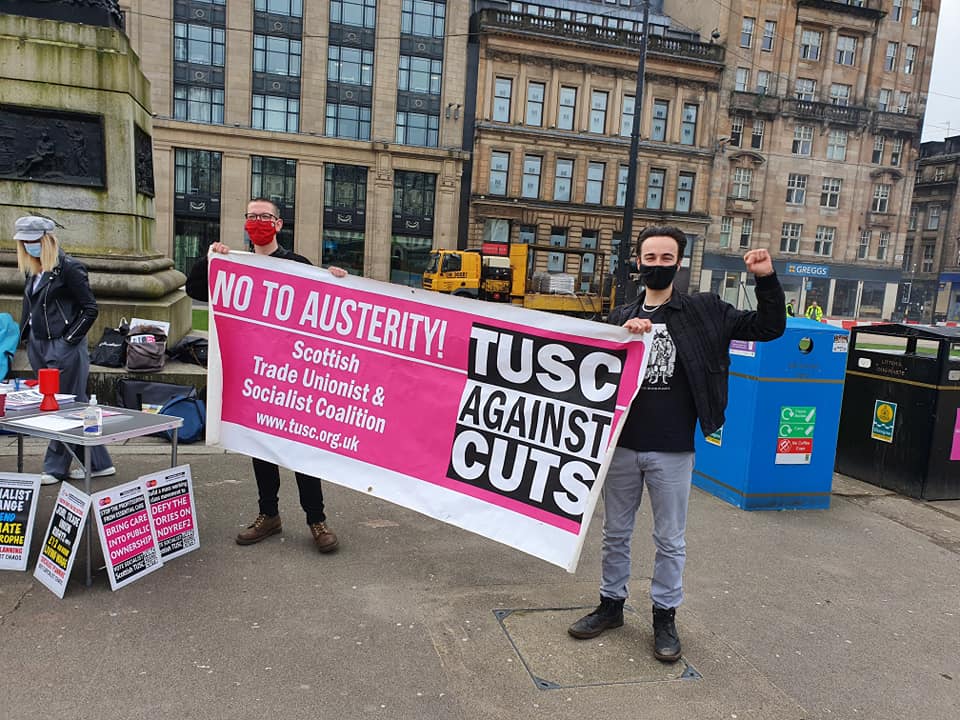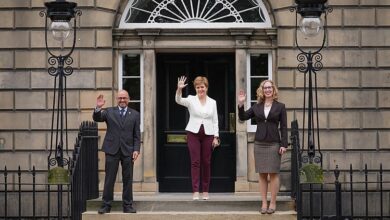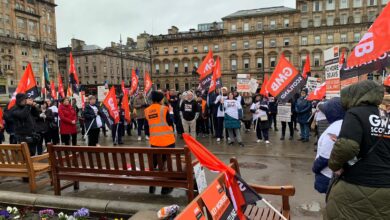Scotland: Pro-independence majority in a highly polarised election

Socialist Party Scotland
Following a highly polarised Scottish election, the SNP will again form the new government at Holyrood.
By winning 64 MSPs – one short of a majority – Nicola Sturgeon’s will be a minority administration. Pro-independence supporting parties – the SNP and Scottish Greens – make up a majority of the 129-seat parliament with 72 MSPs
The Scottish Greens will also continue to support the SNP by voting for their budgets. A formal coalition is unlikely at this stage.
The outcome sets the Scottish parliament – and more importantly a majority of the Scottish working class – on a collision course with a Boris Johnson-led Tory government. Johnson has so far ruled out granting the powers for a second referendum, no matter the outcome of the election.
The scene is therefore set for an explosive confrontation over the national question. Despite the victory of the SNP in the election they have no strategy for taking on and defeating the Tories and capitalism’s opposition to indyref2. In particular, Nicola Sturgeon is mortally opposed to mobilising mass working class struggle to win democratic rights.
The SNP won 62 of the 73 constituencies with a record 1.3 million votes. The largest vote for a party in the 22-year history of the parliament. Nicola Sturgeon’s party also won two seats on the regional lists but were short of the required 65 for a majority.
The Tories, yet again, defeated Labour, coming second with 31 MSPs and are the largest of the pro-union parties.
Labour underwent no significant recovery under their new Blairite leader Anas Sarwar. Indeed they ended up with two fewer seats than 2016 with 22 MSPs. It was Labour’s worst ever performance in a Scottish parliament election.
The Scottish Greens increased their representation to eight from their previous six. All of them elected on the regional lists
Alba, the new party formed by former SNP leader Alex Salmond just before the election, failed to win any MSPs.
The turnout was a record for a Holyrood poll at 63%
Overall, roughly half of those voting backed pro-independence parties while half voted for pro-union parties.
Election results in England and Wales saw sitting government parties receiving a certain Covid bounce, reflecting the vaccine roll out and the move out of lockdown.
While Nicola Sturgeon’s handling of the pandemic would also have also boosted the SNP, it was independence that dominated the election.
Polarisation over independence
The polarisation over independence was the overwhelming factor with a for or against indyref2 guiding how people voted.
In some areas Labour voters backed the Tories to stop the SNP, Tory supporters voted Labour to do the same. Pro-independence working-class voters overwhelmingly backed the SNP.
Tactical voting in seats where there was a close contest between the SNP and a pro-union party was clearly evident.
For example in Dumbarton, a Labour/SNP marginal, there was a sizeable swing from the Tories to Labour to hold off the SNP. In Eastwood, Labour voters in large numbers backed the Tory candidate to prevent the SNP from winning. This pattern was repeated in seats across Scotland.
While a majority of the working class and the overwhelming majority of young people support independence, there is significant opposition clearly reflected in the election outcome.
The SNP with their pro-capitalist vision of independence are incapable of overcoming the genuine fears of some, particular older workers. It also leaves a space for the Boris Johnson, the Tories and right wing Labour to exploit now and in the future by whipping up a form of British nationalism.
To win a decisive majority for independence and to overcome those fears requires socialist policies. By fighting for an independent socialist Scotland that would end austerity, poverty and inequality those fears can be overcome. Particularly if socialist independence is put in the context of a united working class and a voluntary socialist federation of Scotland with England, Wales and Ireland.
Scottish Labour were again decimated in their former working-class heartlands, winning only a single constituency seat in the Glasgow/West Scotland/Central Scotland region and two constituency seats overall.
There can be no real recovery for Labour among the working class if they are led by the Blairites and continue to oppose the right to self-determination. An urgent task is to build a new mass workers’ party based on the trade unions in Scotland.
Socialist campaign
Socialist Party Scotland advocated consistently the need to stand working class, socialist candidates to make the case that no other party would make: for a socialist recovery for the working class after the pandemic; for pay rises, jobs and homes and for the building of a mass movement for indyref2 and an independent socialist Scotland.
We were the only socialist organisation in Scotland prepared to put up candidates. Most of the socialist left groups that had stood in the past – SSP, Rise, SWP etc – retreated, bowed by the pandemic and the temporary moods to back the SNP or the Greens as the best available option.
Socialist Party Scotland was a key driving force in supporting the Scottish Trade Unionist and Socialist Coalition (Scottish TUSC) campaign. Scottish TUSC stood in three regions and three constituencies. All Scottish TUSC candidates were members of Socialist Party Scotland
We ran a strong campaign in the areas we stood in with outstanding candidates, including trade union leaders, working class women and young comrades standing for the first time. In all 1.1 million Scottish TUSC leaflets went to every home in the six areas we stood in.
With the election being so polarised and taking place against the backdrop of a focus on the pandemic, the space for a socialist alternative was limited.
More than 99% of the votes on the constituencies went to the pro/anti-indy blocs.
There was an overwhelming mood in many working class areas to defy the Tories and back the SNP to ensure a second referendum. That included a big layer who were sympathetic to socialist ideas and had an SNP-critical outlook. However the pressure to deliver as big a vote as possible for independence was a major factor.
Nevertheless, we won over 700 votes across the two Dundee seats and 230 votes in Aberdeen Donside
This polarisation was also reflected by the vote on the regional lists with 95% of the votes going to either of the two blocs. Here the Scottish TUSC vote was squeezed further by the fact that there were between 16 and 22 options on the ballot paper.
In Glasgow region the Scottish TUSC vote was 645. In West Scotland it was 479 and Highlands and Islands 280 votes.
It’s clear that the priority for many working-class people was to vote for the party on the regional list most likely to deliver a pro-independence majority – in this case the SNP or for some young people especially the Scottish Greens.
Even Alba – a party led by a former first minister and with sitting MPs and councillors, regular press coverage and aspirations to enter the parliament – could not withstand that pressure and polled 1.6% on the regional lists.
However, Alba can develop a bigger electoral base in the future by basing themselves on an increasing layer of the independence movement who are critical of the SNP leadership.
These modest votes for Scottish TUSC are far from the whole picture. There was a large amount of support and sympathy for our ideas from a much wider section of the working class and young people.
The mass distribution of our leaflets, the big increase in our social media campaign and the response to our public activity all found significant support for socialist ideas generally.
Proud to vote socialist
One of the features of the Scottish TUSC campaign was the evident enthusiasm among those who supported us.
Some examples included from young people on Twitter who we did not know previously: “Go out and vote today guys! I’m voting @ScottishTUSC as they’re the only Scottish party that seem to care about helping the working class”.
“Vote @ScottishTUSC to actually make a difference and stray away from anti-working class parties.” “I voted for TUSC on the regional ballot and i’m proud of it.”
After the election a leading trade unionist in Glasgow messaged to say: “I really think the profile of socialism on the political spectrum has been raised. Thanks to all TUSC candidates in this election.”
Another told us: “I think TUSC ran a great campaign. Many, many were impressed and ready to hear socialist ideas. Well done on a brilliant campaign.”
And as one emailer put it: “I am a proud voter for Scottish TUSC at the Highlands and Islands regional ballot, saw your message online and I am desperate to get involved.”
We were also pleased to have the support of leading NHS pay campaigners, 2018 Glasgow equal pay strikers and RMT activists among many others.
Donations to our campaign eclipsed anything we have achieved before, including from CWU members, Unison reps and the RMT.
Overall, the Scottish TUSC campaign was simply necessary. With an array of pro-capitalist options on the ballot, the need for a fighting socialist alternative was essential.
Well done to all the candidates and activists who ensured that in an election of competing flags, the red flag – the symbol of the working class and socialism – was flown high.
Now, the attention of workers and young people will turn to the struggles that impend. On the fight for the right to decide and an indyref 2. On pay rises, jobs, affordable homes and a future free from a system that benefits only the rich and the billionaire class. On the fight for an independent socialist Scotland and for socialist world.
Socialist ideas will gain growing and deeper traction in the new post-Covid period. The need to build fighting trade unions and a new mass workers’ party is an ever more urgent task. The seeds planted in this election will grow and become a powerful material force.
Socialist Party Scotland appeals to all who voted socialist on May 6 to join us in that struggle.
Come to our meeting on Thursday May 13 at 7.30pm – What is socialism and why should you fight for it.
Join Zoom Meeting
https://us02web.zoom.us/j/83521674903
Scottish TUSC votes
Dundee West 432 (1.3%)
Dundee East 287 (0.9%)
Aberdeen Donside 240 (0.7%)
Glasgow region 645 (0.2%)
West Scotland 479 (0.1%)
Highlands and Islands 280 (0.1%)
Total 2,363
Election analysis from our comrades in England and Wales
https://www.socialistparty.org.uk/articles/32480/09-05-2021/hartlepool-sums-up-labour-crisis



